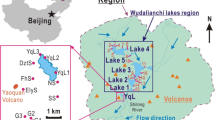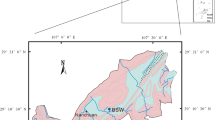Abstract
The carbon cycle in a global sense is the biogeochemical process by which carbon is exchanged among the biosphere, pedosphere, geosphere, hydrosphere, and atmosphere of the earth. For epikarst systems, it is the exchange of carbon among the atmosphere, water, and carbonate rocks. Southern China is located in the subtropical zone; its warm and humid weather creates favorable conditions for the dynamic physical, chemical, and ecological processes of the carbon cycle. This paper presents the mechanisms and characteristics of the carbon cycle in the epikarst systems in south China. The CO2 concentration in soils has clear seasonal variations, and its peak correlates well with the warm and rainy months. Stable carbon isotope analysis shows that a majority of the carbon in this cycle is from soils. The flow rate and flow velocity in an epikarst system and the composition of carbonate rocks control the carbon fluxes. It was estimated that the karst areas in south China contribute to about half of the total carbon sink by the carbonate system in China. By enhancing the movement of elements and dissolution of more chemical components, the active carbon cycle in the epikarst system helps to expand plant species. It also creates favorable environments for the calciphilic plants and biomass accumulation in the region. The findings from this study should help in better understanding of the carbon cycle in karst systems in south China, an essential component for the best management practices in combating rock desertification and in the ongoing study of the total carbon sink by the karst flow systems in China.


Similar content being viewed by others
References
Amundson RG, Davidson EA (1990) Carbon dioxide and nitrogenous gases in the soil atmosphere. J Geochem Explor 38:13–41
Cao JH, Pan GX, Yuan DX (1999) Atmospheric dynamic and environmental significance of eco-system in karst depression region in Guilin. Geol Rev 45(1):106–111 (in Chinese)
Houghton RA, Woodwell GM (1989) Global climate change. Am J Sci 260:18–26
Institute of Soil Science of Chinese Academy of Science (ISSCAS) (1978) Soils in China. Science Press, Bei**g, p 51–55 (in Chinese)
Integrated Survey Team from the Nonggang Natural Reserve Agency (1988) Comprehensive report on the Nonggang natural reserve in Guangxi. Guangxi Plant, supplement: 51–73 (in Chinese)
Jiang ZC (1996) An analysis on formation of fengcong depressions in China. Carsologica Sinica 15(1–2):83–90
Jiang ZC (1997) Geochemical migration of elements in dolomite environment in Nongla Guangxi. Carsologica Sinica 16(4):304–311 (in Chinese)
Jiang ZC (1999) Migration of chemical elements in karst dynamic system. Geography 54(5):438–443 (in Chinese)
Jiang ZC, Yuan DX (1998) Ecological features of plants and environment management in southwest karst regions. In: Shao SX, Hou CT (eds) “National Agricultural Research Progress”, International Scientists Press, Hong Kong, p 78–83 (in Chinese)
Li B (1996) Source and sink relationship between carbon cycle of karst region and atmospheric CO2. In: Yuan DX, **e YH (eds) “Karst and human survival, environment, resource and disaster” Guangxi Normal University Press, Guangxi, pp 64–70 (in Chinese)
Liu ZH (2001) Role of carbonic anhydrase as an activator in carbonater dissolution and its implication for atmospheric CO2 sink. Acta Geol Sinica 75(3):275–278
Shen JF, Li YY, Song RC (1996) Karst research of Qingjiang basin. Geology Press, Bei**g, p 178–179 (in Chinese)
Song LH (1981) Progress of karst hydrology in China. Prog Phys Geogr 5:563
Trudgill ST (1985) Limestone geomorphology. Longman, London, pp 10–32
Weng JT (1995) The impact of carbonate rocks to global carbon cycle. Earth Sci 10(2):154–158 (in Chinese)
Xu ZR (1993) Plant research of limestone region in south and southwest China. Guangxi Plant, supplement: p 22–23 (in Chinese)
Xu SY, He SY (1999) Dynamic feature of soil CO2 in carbonate salt rock and its driven function to the dissolution. In: Yuan DX (ed) “The 30th international geological conference” Geology Press, Bei**g, 24:p 96–102 (in Chinese)
Xu SY, Jiang ZC (1997) Initial estimation of the relation between karst reaction and climate greenhouse gas. Sci Bull 42(9):953–956 (in Chinese)
Yang LZ, Wei J (1996) Carbon cycle in karst system and its environmental impact. In: Yuan DX, **e YH (eds) “Karst and human survival, environment, resource and disaster” Guangxi Normal University Press, Guangxi, pp 34–43 (in Chinese)
Yu JB, Yang LZ, Zhang HS (1990) Characteristic of karst development in China-evaluation and management of karst water resources in southern Puding, Guizhou. Science Press, Bei**g, p 40–48 (in Chinese)
Yuan DX (1993) Carbon cycle and global karst. Quatern Res 1:1–6 (in Chinese)
Yuan DX (1997) The carbon cycle in karst. Annu Geomorphol 108:91–102
Zhou ZX (1987) Scientific survey of forests in karst region. Guizhou People’s Publishing House, Guizhou, p 122–156 (in Chinese)
Acknowledgments
This research was jointly sponsored by the China Geology Survey (Grant No. 1212011087121) and the Ministry of Science and Technology of China (Grant No. 2010BAE00739). We would also like to thank Dr. Shiyi He, Mr. Jianguo Pei, and Dr. Cheng Zhang of the Institute of Karst Geology for their help in fieldwork.
Author information
Authors and Affiliations
Corresponding author
Rights and permissions
About this article
Cite this article
Jiang, Z., Lian, Y. & Qin, X. Carbon cycle in the epikarst systems and its ecological effects in South China. Environ Earth Sci 68, 151–158 (2013). https://doi.org/10.1007/s12665-012-1724-x
Received:
Accepted:
Published:
Issue Date:
DOI: https://doi.org/10.1007/s12665-012-1724-x




